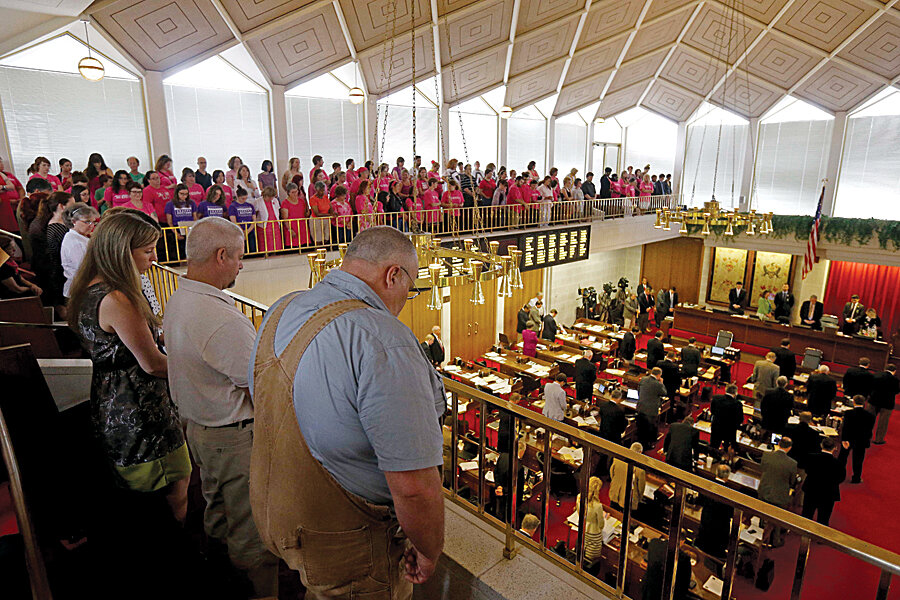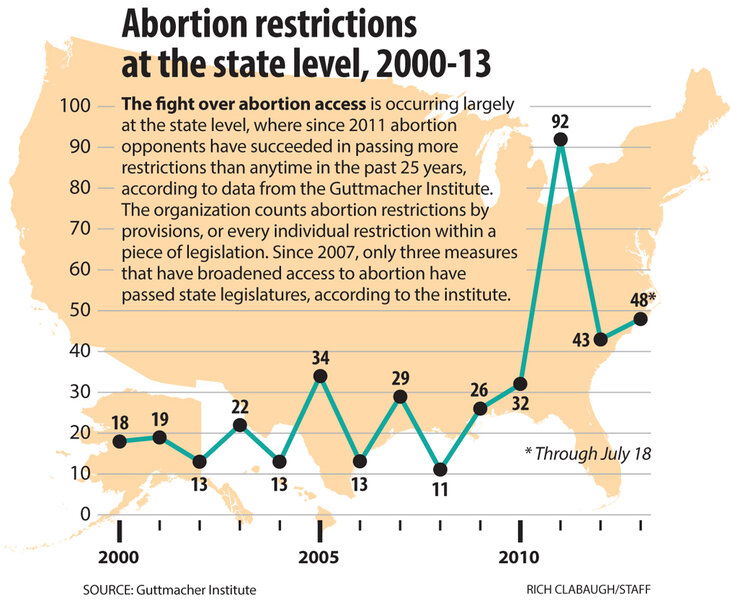As abortion limits sweep US, even 'purple' states join the crackdown
Loading...
| RALEIGH, N.C.
Mary Lucas, clad in a pink Planned Parenthood T-shirt, holds onto her handmade poster resolutely: "If NC legislators are against Sharia law, WHY are they trying to impose it on NC women?"
She's one in a sea of fellow North Carolinians agitating outside the state legislature as part of the 11th "Moral Monday" protest – a weekly cri de coeur organized by the National Association for the Advancement of Colored People against the state's new conservative tilt. The focus of this evening is women's reproductive rights.
Before the night was out, 101 people would be arrested for civil disobedience.
Before the end of July, the legislature would pass and the newly elected Republican governor would sign a series of new regulations on abortion, including tougher rules for clinic facilities and doctors.
The measure's proponents say they are protecting women, especially after the gruesome revelations that came out of the recent murder trial of Philadelphia abortionist Kermit Gosnell. Opponents say the requirements are costly and unnecessary and could drive many of the state's 16 clinics out of business.
Forty years after the US Supreme Court legalized abortion nationwide in Roe v. Wade, the abortion wars are raging as hot as ever. From Texas to North Carolina to Wisconsin to Ohio, to name just the most recent examples, states across America are enacting new restrictions in a wave that began in 2011 – a direct result of the conservative backlash of 2010 that swept Republicans into power in the US House, state legislatures, and governor's chairs. Some have made regulating abortion a top priority.
If 2011 saw a peak in the passage of post-Roe abortion restrictions at the state level – 92 – then 2013 is poised to come in second. As of July 30, the number of new restrictions is at 55, past the total of 43 for all of 2012, according to the pro-abortion-rights Guttmacher Institute, which researches reproductive health matters.
And like the political map of the country, divvied up into red and blue states, so, too, are the states increasingly polarized over abortion. Solid-red Texas now has some of the toughest restrictions in the nation, including a just-signed ban on abortion after 20 weeks of pregnancy. At the other end of the spectrum, solid-blue California is moving to expand access to early-term abortions by allowing nurse practitioners, nurse midwives, and physician assistants to perform certain types.
A survey by the Pew Research Center released July 29 shows that while public opinion nationally on abortion has held fairly steady, regional differences are widening. Opposition to abortion in the South has grown markedly in the past 20 years even as other parts of the nation – such as New England – have seen support rise.
But in the realm of new abortion laws, there are far more Texases than Californias. And now there's a new wrinkle: Moderate, battleground states – the "purple" states that decide presidential races, such as North Carolina, Ohio, Wisconsin, and Virginia – are joining the abortion crackdown as never before. In 2008, all four voted for Barack Obama for president. In 2012, all but North Carolina voted to reelect him.
Their recent moves guarantee that the abortion issue will be front and center in the next election. "North Carolina tells the story of a number of states that have become much more energized around the abortion issue than they have in a long time," says Elizabeth Nash, state issues manager at the Guttmacher Institute. "There just aren't that many states in the middle on abortion anymore."
States are also increasingly polarized over broader issues of reproductive health – access to birth control (by defunding Planned Parenthood at the state level), the approach to sex education in schools, and how reproductive health intersects with "Obamacare." As of July 1, twenty-two states prohibit abortion coverage in the state health-insurance exchanges that are being set up. And at least 21 states are opting out of Medicaid expansion, which means less reproductive health care for poor women.
But abortion is the hot topic in the world of reproductive policy. Take Virginia. In 2011, the legislature passed a bill requiring abortion facilities to upgrade to hospital-level standards, such as wider hallways and bigger closets. This past April, Hillcrest Clinic in Norfolk, Va., closed its doors, citing the expense of compliance as the main reason. (Another reason, it must be noted, is that demand for abortion had declined, owing to more effective use of birth control.)
In mid-July, the busiest clinic in Virginia – NOVA Women's Healthcare in Fairfax – closed after failing to find a new location so it could comply with the new law. When the city council learned of the effort to relocate, it voted to reclassify abortion clinics as medical-care facilities and require them to obtain approval from the council.
If North Carolina and Virginia have only recently become electoral battlegrounds, Ohio and Wisconsin are veterans. But with Republican governors, they, too, have now passed new abortion restrictions. In Ohio, Gov. John Kasich (R) just signed a two-year budget that requires clinics to have admitting privileges at hospitals, but not public ones. It also defunds Planned Parenthood; targets funds to "crisis pregnancy centers," which discourage abortion; and requires an ultrasound test before an abortion, among other provisions.
Wisconsin also now requires a pre-abortion ultrasound and hospital admitting privileges for clinics. Opponents say the new restrictions could close two of the state's four clinics, and they've filed a federal lawsuit.
Abortion foes are almost pinching themselves as their cause picks up momentum.
"We were expecting a slowdown; so to come out of an election year with this kind of activity, we're very pleased," says Charmaine Yoest, president of Americans United for Life, a major source of model legislation for states. "All the new laws have increased awareness that we can make progress on the life issue without overturning Roe."
Barbara Holt remembers well the day she talked a college friend out of having an abortion. This was before the 1973 Roe decision. But North Carolina had already begun to liberalize its abortion laws – one of the earliest states to do so, though more out of racial motives than to promote women's rights – and thus her friend had that option.
"She didn't abort," Ms. Holt says. "She married the fella, and they had other children."
That early experience stuck with Holt; after Roe, she joined the nascent antiabortion movement. Her determination was later fueled by her own infertility and then the adoption of her son. Now, after 23 years as president of North Carolina Right to Life and many lean years with her legislative allies in Raleigh stuck in the minority, she has won a victory in the legislature for the second session in a row.
This time, there's a Republican governor who was willing to sign the bill, which he did on July 29. No override of a Democratic governor's veto was needed, as it was in 2011, when the legislature passed a series of requirements, including one requiring a physician to perform an ultrasound and describe the image to a patient before the abortion. A federal judge later blocked implementation of that aspect on First Amendment grounds, pending a resolution of the challenge to the law.
This year, the new measure includes a requirement that abortion clinics upgrade facilities to meet the standards of ambulatory surgical centers, a rule that a doctor be present for an entire surgical abortion and for the first dose of a chemical abortion, and a ban on sex-selection abortions. Currently, only one clinic in North Carolina meets the surgical center standard. Upgrades to the other 15 could be costly.
Compared with Texas, where Gov. Rick Perry (R) just signed a ban on most abortions after 20 weeks of pregnancy – the 12th state to do so – North Carolina has been more subtle in its moves. That is by political necessity. During his successful campaign for governor last year, Pat McCrory (R) said he would not sign any new restrictions on abortion, and he pledged to veto the legislation as originally written.
The original Senate bill was attached, without advance public warning, to an unrelated measure banning sharia (Islamic law).
After a rewrite passed the House – attached to an equally unrelated measure dealing with motorcycle safety – Governor McCrory said he would sign it (once the Senate passed it). To abortion-rights advocates, it's an unhappy compromise. It authorizes the state health department to apply the new clinic standards "while not unduly restricting access." For now, clinic advocates are hopeful the current health secretary, Aldona Wos, will protect access to abortion.
"But Secretary Wos is not going to stay there forever," says Paige Johnson of Planned Parenthood of Central North Carolina. "What this legislation does is it punts women's health into the political arena in a way that it has never been before."
Abortion foes aren't wild about the compromise language, but they can live with it. And this new measure is far from the final word.
"You can expect more pro-life legislation every year," says Tami Fitzgerald of the North Carolina Values Coalition.
She and others can expect equally determined pushback. "As North Carolina becomes more metropolitan, more cosmopolitan, Planned Parenthood has strong support," says Ferrel Guillory, an expert on the state's politics at the University of North Carolina, Chapel Hill. "But you also have the noteworthy legacy of [former Sen.] Jesse Helms and the Moral Majority, and now add on the tea party. So North Carolina comes across about as polarized as the rest of the nation."
Travel south to Mississippi, and it's a different world. The state has only one abortion clinic, located in Jackson, and it's hanging on by a thread.
A 2012 state law requires each doctor who performs abortions there to gain admitting privileges at a local hospital, though none have been granted. That would spell the end of the clinic, but for a federal judge who blocked the closing in April pending a decision on the constitutionality of the law.
The doctors who serve that clinic travel to Jackson from out of state, including one from Chicago. "The political climate is so toxic, no one can live in Mississippi," says Ms. Nash of the Guttmacher Institute. "If you say you're an abortion provider, you have people following you around."
Proponents of an admitting-privileges rule say it protects women's health – though the governor and some legislators didn't hide their true intent, which is to close the Jackson clinic.
Opponents of the law say a formal agreement for admitting privileges is not necessary to protect women: On the rare occasion when complications occur, any emergency room would take the patient.
If the Jackson Women's Health Organization were to close, Mississippi would become the first state in the country with no abortion clinic. Mississippi women seeking a legal abortion would have to leave the state. And that "would result in a patchwork system where constitutional rights are available in some states but not others," federal district Judge Daniel P. Jordan III wrote in April when he blocked the closing of the clinic.
If the case were to reach the US Supreme Court, the presumed swing vote is Justice Anthony Kennedy. And with Justice Kennedy, it's anyone's guess which way he would go.
"I could easily spin it that Kennedy would find it offensive to have a state in which abortion is not at all available," says David Garrow, a professor of history and law at the University of Pittsburgh. "But I could also spin it that Kennedy would not think having to drive from Jackson to Memphis [Tenn.] or New Orleans is a burden."
The stakes for such a case go far beyond Mississippi: Seven other states have laws requiring hospital admitting privileges. One is North Dakota, which also has just one clinic, in Fargo. That clinic is challenging in court a slew of other new restrictions, including one that bans abortion when a fetal heartbeat is detected, which can happen as early as six weeks into a pregnancy. On July 22, a federal judge blocked enactment of the law, saying it directly contradicts Supreme Court precedent.
Under Roe, states may not ban abortion before fetal viability, which typically occurs between 22 and 24 weeks of gestation. Twelve states have enacted abortion bans at 20 weeks. This raises the issue of how doctors calculate the length of a pregnancy, a matter that could affect whether the laws are found constitutional.
But it's the other, more seemingly subtle restrictions that could actually bring more change. "Stuff that's usually 'below the media radar' – clinic building standards, doctors' admitting status – may well have much more of a long-term impact on geographic unavailability than things that get much more attention, e.g., 20-week bans, but that are struck down by federal courts," Professor Garrow says.
If these "below the radar" restrictions are allowed to stand, what then for the future of abortion rights?
Ted Joyce, an expert on the economics of abortion at Baruch College in New York, anticipates a "blue state, red state" distribution of abortion services if courts uphold these restrictions, including requirements for "informed consent" and multiple trips to comply with waiting periods.
The result will be a concentration of services in large urban areas that have the patient base needed to finance the construction of new clinics – or the retrofitting of old ones – to meet the new standards, Professor Joyce says.
"Urban density will also lessen the impact of two-trip requirements as well as the difficulty of recruiting MDs with local admitting privileges," he says in an e-mail. "Thus, Dallas-Fort Worth, Atlanta, Miami, Memphis, Chicago, Denver, and St. Louis become the regional centers for abortion services for the South and Midwest."
For patients, more travel means higher cost. But Joyce does not foresee much effect on abortion rates among women under 10 weeks of pregnancy, since they tend to be clearer about their decision to terminate.
"But I would predict that abortion rates at 16 weeks or later will decline," he says, "because women who terminate at these gestations are more likely to be younger, poorer, and more ambivalent."









